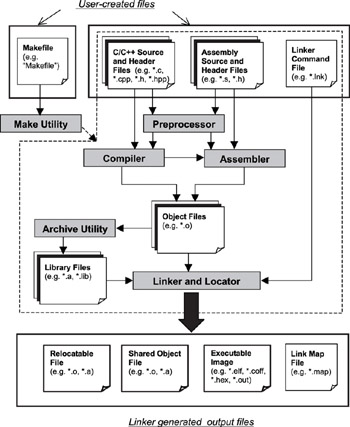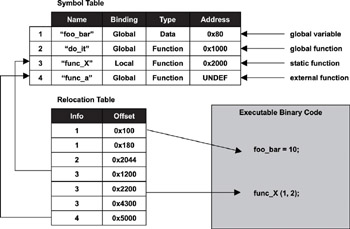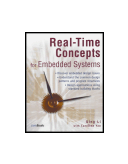Книга: Real-Time Concepts for Embedded Systems
2.2 Overview of Linkers and the Linking Process
2.2 Overview of Linkers and the Linking Process
Figure 2.2 illustrates how different tools take various input files and generate appropriate output files to ultimately be used in building an executable image.

Figure 2.2: Creating an image file for the target system.
The developer writes the program in the C/C++ source files and header files. Some parts of the program can be written in assembly language and are produced in the corresponding assembly source files. The developer creates a makefile for the make utility to facilitate an environment that can easily track the file modifications and invoke the compiler and the assembler to rebuild the source files when necessary. From these source files, the compiler and the assembler produce object files that contain both machine binary code and program data. The archive utility concatenates a collection of object files to form a library. The linker takes these object files as input and produces either an executable image or an object file that can be used for additional linking with other object files. The linker command file instructs the linker on how to combine the object files and where to place the binary code and data in the target embedded system.
The main function of the linker is to combine multiple object files into a larger relocatable object file, a shared object file, or a final executable image. In a typical program, a section of code in one source file can reference variables defined in another source file. A function in one source file can call a function in another source file. The global variables and non-static functions are commonly referred to as global symbols. In source files, these symbols have various names, for example, a global variable called foo_bar or a global function called func_a. In the final executable binary image, a symbol refers to an address location in memory. The content of this memory location is either data for variables or executable code for functions.
The compiler creates a symbol table containing the symbol name to address mappings as part of the object file it produces. When creating relocatable output, the compiler generates the address that, for each symbol, is relative to the file being compiled. Consequently, these addresses are generated with respect to offset 0. The symbol table contains the global symbols defined in the file being compiled, as well as the external symbols referenced in the file that the linker needs to resolve. The linking process performed by the linker involves symbol resolution and symbol relocation.
Symbol resolution is the process in which the linker goes through each object file and determines, for the object file, in which (other) object file or files the external symbols are defined. Sometimes the linker must process the list of object files multiple times while trying to resolve all of the external symbols. When external symbols are defined in a static library, the linker copies the object files from the library and writes them into the final image.
Symbol relocation is the process in which the linker maps a symbol reference to its definition. The linker modifies the machine code of the linked object files so that code references to the symbols reflect the actual addresses assigned to these symbols. For many symbols, the relative offsets change after multiple object files are merged. Symbol relocation requires code modification because the linker adjusts the machine code referencing these symbols to reflect their finalized addresses. The relocation table tells the linker where in the program code to apply the relocation action. Each entry in the relocation table contains a reference to the symbol table. Using this reference, the linker can retrieve the actual address of the symbol and apply it to the program location as specified by the relocation entry. It is possible for the relocation table to contain both the address of the symbol and the information on the relocation entry. In this case, there is no reference between the relocation table and the symbol table.
Figure 2.3 illustrates these two concepts in a simplified view and serves as an example for the following discussions.

Figure 2.3: Relationship between the symbol table and the relocation table.
For an executable image, all external symbols must be resolved so that each symbol has an absolute memory address because an executable image is ready for execution. The exception to this rule is that those symbols defined in shared libraries may still contain relative addresses, which are resolved at runtime (dynamic linking).
A relocatable object file may contain unresolved external symbols. Similar to a library, a linker-reproduced relocatable object file is a concatenation of multiple object files with one main difference-the file is partially resolved and is used for further linking with other object files to create an executable image or a shared object file. A shared object file has dual purposes. It can be used to link with other shared object files or relocatable object modules, or it can be used as an executable image with dynamic linking.
- Разработка приложений баз данных InterBase на Borland Delphi
- 4.4.4 The Dispatcher
- Open Source Insight and Discussion
- Introduction to Microprocessors and Microcontrollers
- About the author
- Chapter 6. Traversing of tables and chains
- Chapter 7. The state machine
- Chapter 8. Saving and restoring large rule-sets
- Chapter 11. Iptables targets and jumps
- Chapter 5 Installing and Configuring VirtualCenter 2.0
- Chapter 16. Commercial products based on Linux, iptables and netfilter
- Appendix A. Detailed explanations of special commands




